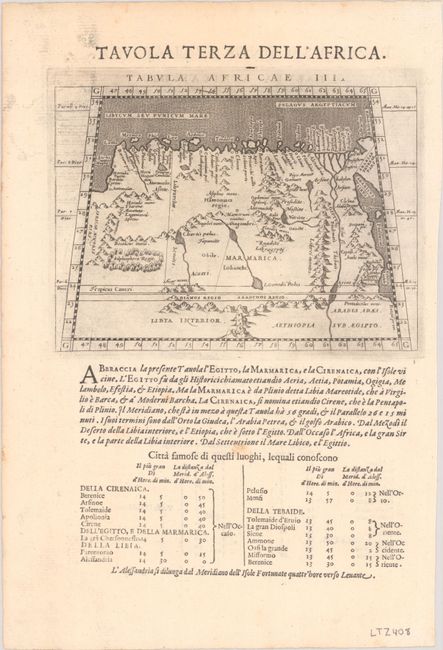Subject: Northern Africa
Period: 1598 (circa)
Publication: Geografia cioe Descrittione Universale della Terra
Color: Black & White
Size:
6.9 x 5 inches
17.5 x 12.7 cm
Claudius Ptolemy was a mathematician, astronomer and geographer who worked in Alexandria, then a part of the Roman Empire, in the 2nd century AD. One of the most learned and influential men of his time, his theories dominated both astronomy and geography for nearly 1500 years. His writings were kept alive by Arabic scholars during the Middle Ages and reemerged in Europe during the Renaissance. The birth of printing led to wide dissemination of his great works on astronomy and geography. There were a number of editions of his Geographia beginning in 1477. These early editions contained maps based on his original writings, known as Ptolemaic maps. As geographic knowledge increased with the explorations of Columbus, Magellan, Cabot and others, maps of the New World were added, and maps of the Old World were revised. Ptolemy's Geographia continued to be revised and published by some of the most important cartographers including Martin Waldseemuller, Sebastian Munster, Giacomo Gastaldi, Jodocus Hondius, and Gerard Mercator (whose last edition was published in 1730).
This sheet features two fine Ptolemaic maps of Northern Africa. The map on recto covers portions of Algeria, Tunisia, and Libya and extends to include the islands of Sicily and Sardinia. The map identifies rivers and mountain ranges in the vicinity, and is decorated by a trio of sea monsters in the stippled sea and an erupting Mount Etna in Sicily. The map on verso depicts eastern Libya and Egypt with numerous ancient place names. The interior is filled with mountains as well as some spurious lakes and rivers. The Nile River valley is shown in nice detail. On a sheet of Italian text measuring 8.1 x 12.1". Published in either 1598 or 1621.
References: Mickwitz & Miekkavaara #226-13 & 14.
Condition: A
Dark impressions on a watermarked sheet with a bit of printer's ink residue. There is light soiling and a few spots of foxing, all confined to the margins.




